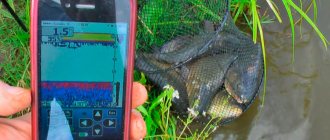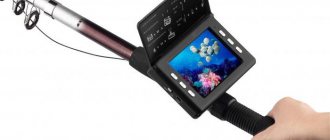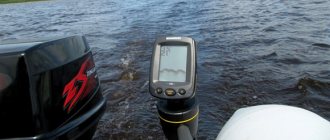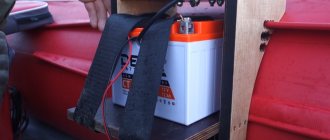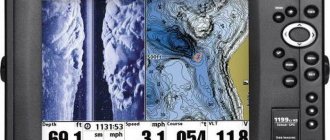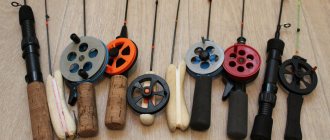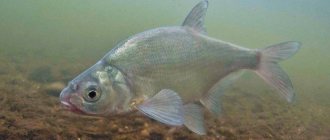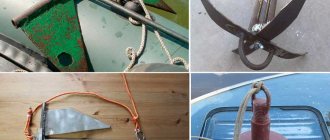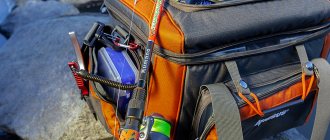An echo sounder is equipment that can be used to determine the location of fish in a body of water. The device saves the fisherman from frequent casting of baits, lengthy exploration of the depths, and makes it possible to increase the catch.
Beginner anglers often don't know how to use a fish finder, but skill comes with practice. The main thing is to follow safety precautions.
How the echo sounder works
Fishermen who are used to relying on their own skills may not understand what a fish finder is for. It is required when you need to quickly find fish, and the area of the reservoir is large. Setting up models is easy; image decoding does not require special knowledge.
If the factory settings are set to the correct mode, the device is able to show a clear picture. It’s better to immediately go to the pond and see how it works. You just need to turn it on on the spot, and then turn it off after fishing.
The echo sounder performs the following functions:
- Determining the distance to the bottom and its relief. With its help you can search for fish and their schools. Fishing with an echo sounder allows you to increase your fish catch.
- Depending on the manufacturer, the device may have other options.
The device consists of 2 blocks. The first is the screen. It has a microcomputer that processes incoming data. The second block is a sensor configured to perceive information.
In addition to such main characteristics as the operating frequency of the device and the number of rays, which determine the class of the device, when choosing, you should pay attention to the display and its quality. The higher the resolution of this node, the more accurate the data that the fisherman will see.
The scheme of work is as follows:
- The transmitter emits an electrical pulse. In the converter, it changes into a sound wave, which is transmitted into the water.
- When it reaches an object located in the water column or at the bottom, it is reflected. After this, it returns to the converter, where it is transformed into an electrical signal. It is amplified by the receiver and sent to the display.
- Sound travels at a constant speed in water, so the time interval between sending a signal and receiving the echo can be measured. This is how the distance to the object is determined.
- The echo sounder sends a wave several times per second, the incoming signal forms a picture that is constantly changing. The device will show not only fish, but also driftwood, accumulations of algae and other objects at the bottom or in the water column.
https://youtu.be/txzM_Ean98E
The devices operate with different wavelengths. Most often this is 192 kHz, but companies produce devices designed for 50 kHz. Although these frequencies belong to the sound range, they are not audible either to people or to the inhabitants of the depths. Therefore, fishermen can be sure that the operating modules do not scare the fish.
The device is used either permanently, attached to the boat, or with a temporary mount.
Its operation is not precise, so different models may provide different results.
The most popular models of echo sounders for fishing from a boat
The market today is replete with a large number of different models, which differ not only in their functions and capabilities, but also in manufacturers and quality. It is extremely difficult to navigate such a wide range of products, but thanks to the accumulated experience in using various devices, we can make a list of the most convenient and effective models:
GARMIN STRIKER PLUS 5CV (Editor's Choice)
- Display Size:
5´´ - Screen resolution:
800 x 480 pixels - Display type:
WVGA color - Waterproof:
yes (IPX7) - CHIRP sonar technology:
yes (built-in) - DownVü:
yes, with CHIRP (built-in) - Radiation power:
500 W (rms) - Dimensions:
18.8 x 11.6 x 5.4 cm - Weight:
0.5 kg - Contents:
Fish finder, power cable, swivel mount, hardware, Garmin bumper sticker
| Quickdraw Contours. Built-in mapping software allows you to create and store 1-foot contour maps covering up to 2 million acres. | GPS Fishfinder. Built-in high-sensitivity GPS receiver finds and maintains your location, allowing you to mark waypoints for different locations. | Garmin CHIRP. Provides an almost photographic, wide view of what passes under the boat, so underwater objects and fish are clearly visible. |
Price without discount: 7860 rub.
Link to the official website. Sometimes there are promotions with significant discounts.
Humminbird 561x - equipped with two beams, a 5-inch display with high contrast, an audible alarm when fish is detected, a temperature sensor and a Russian-language menu.
Lowrance HDS is already a multifunctional echo sounder of an above-average class and is one of the best models of its kind. It is indispensable when fishing from boats and boats, and the new version of the operating system introduced into this model allows this device to occupy a leading position among top-end echo sounders.
The Humminbird 570x DI is an improved version of the 561x with the addition of some new features and a larger display size. Since this line of locators continues to develop and improve, it is currently discontinued from mass production.
Humminbird FB 120x - refers to a special type of tube devices. The main specific difference from analogues is the ability to work in two different modes: standard using a single beam and combined mode with side view.
Humminbird 798cx iHDSI Combo – the release of this echo sounder was a revolutionary breakthrough in the market for these devices. This is due to the presence of a fundamentally new technology that allows you to view a three-dimensional image of a surface at an angle of 180 degrees. It also has a reinforced processor, slots for additional memory cards, the ability to connect to other echo sounders via the INTERLINK network and transmit video data.
The Humminbird 597cxiHDDI Combo is a currently discontinued echo sounder that has long been one of the leaders in this line. It is not just an ordinary locator, but an entire independent navigation system with a multi-channel GPS chartplotter. Additional capabilities are provided by the presence of special slots for marine charts, which can be used to save video recordings.
Correct setup of the device
Not everyone understands the principle of operation of an echo sounder. It is based on the interaction of a microphone and a timer, to which a loudspeaker is added. In most devices, the first and second parts are combined into 1 body, this increases ease of use.
To use a fish finder most effectively, a fisherman must set it up correctly. To do this, you should perform the following steps:
- Factory settings are saved in memory, so you can change them by experimenting.
- The fisherman can determine in advance at what depth he will fish, and then manually set the indicator.
- Increase the sensitivity level, bring it to 75%. The parameter is adjusted in accordance with the circumstances in which fishing is planned.
- Change screen settings to achieve maximum sharpness.
- Adjust additional parameters, such as noise reduction, image cleaning, etc., with which you can improve the clarity of the picture.
It is worth paying attention to the batteries. Fishermen have to buy a power supply separately, as it is often not included in the package. In the factory configuration it is only available on expensive models.
You can buy a small battery, you don’t need a powerful one. This device requires little energy to operate; it operates for 4-7 ampere hours for 2 days.
Useful rules for catching pike with an echo sounder
If you confidently decide to use an echo sounder to catch the main predator of reservoirs, then you need to remember a few main rules:
- You should not try to catch exactly those pikes that were highlighted by the echo sounder, especially if their population in the reservoir is quite large. They may not respond to your manipulations, and time will be lost;
- It is recommended to look for areas where several fish are visible on one edge, located very close to each other. The optimal depth in this case is from 5 to 7 meters. Once detected, such an area is marked with buoys;
- if the pike was found at a depth of less than five meters, then it is recommended to catch it using a spinning rod. Tests should be performed at intervals of 20-30 minutes;
- if there are few pikes in the reservoir, and the echo sounder is single-beam, then it is better to look not for individual fish, but for the best places for their habitat;
- if a predator is not detected in its frequent places of residence or quickly flashes on the monitor, then this indicates the presence of a zhor. In this case, you need to postpone the search and start fishing.
Using an echo sounder when fishing for pike allows you to monitor its behavior and thereby adjust your actions. Thanks to this, fishing becomes not only more successful, but also exciting.
How to look for fish?
The instructions for the echo sounder do not tell you how to fish with it. Those anglers who are thinking about purchasing a device should learn about its uses in advance.
Land fishing is one of the most common ways to use a fish finder. It is based on the search for unusual bottom topography. These are dumps, bottom holes.
The device also shows depth differences. Predatory fish are attracted to such places, because they sit in ambush there. Forage fish, which are of interest to predators, also flock here.
You can catch fish from a coastal dump; this is the easiest way to catch it using an echo sounder “from the relief”. There are dumps on any reservoir, and the coastal section is quite long. To determine the direction of fall, it is recommended to take measurements in several places.
Then they stage it, there are 3 ways. This is not only for a dump or aground, but also for depth. In practice, you can use any option. Once the area has been explored, you should move further along the slope. If there are no bites in one place, this does not mean that the result indicates that the fisherman’s actions were incorrect.
Other fishing methods using an echo sounder are similar. Often fish are caught “from under the whites”. Using the device, you can find schools of forage fish; such objects attract predatory inhabitants of the depths.
Using this method, fishermen capture the largest trophies. These are large pike, perch and pike perch. This tactic is best used in the fall, when forage fish move across the reservoir in large schools, moving to deeper areas of the reservoir.
When searching for fish, you should not concentrate on sparsely scattered fish icons or dots. The fisherman should be interested in the “solid wall”, which represents the con.
Using side-view systems is fishing “from structure.” The advent of side-viewing devices was a breakthrough, because they show what is under the ship and to the sides from it at a distance of 20 to 40 m or more. With this tool you can see large fish, such as pike.
Information on the screen
Finding fish with an echo sounder is effective, but working with the image on the screen should be based on information about how many beams the device has. If 1, then the picture will be flat and the movement of objects will be shown as a line. The rise of the fish towards the bait will show an arc.
A device with 2 beams forms a clearer image on the screen, and a three-beam echo sounder shows the position of objects in space on the screen. Multibeam models show a three-dimensional image.
The fish is clearly visible - an object on the screen of the echo sounder with a carplotter, which combined the navigator with echolocation.
What parameters should you pay attention to when buying an echo sounder?
Since the range of this type of sonar on the modern market is very large, most of them have some fundamental differences from their analogues. Therefore, you need to take your choice extremely seriously, comparing the characteristics and parameters of different models before making a purchase. First of all, the following parameters are extremely important:
- power is one of the most important parameters when choosing locators of any type. The quality and level of the signal, and, consequently, the image that is displayed on the display, directly depends on the power. This is most important when fishing at great depths or in reservoirs with poor visibility due to severe turbidity of the water. Also, the detail of the bottom relief and the ability to notice not only large and medium-sized, but also the smallest fish depend on the power. This characteristic can be checked in the passport or operating manual of the device; power is measured in Watts.
- The sensitivity of the signal receiver is another important parameter that should have a golden mean when choosing a suitable model. This is due to the fact that a low-sensitive receiver will not be able to catch strong waves, and a device with high sensitivity, on the contrary, will create multiple interferences.
- Another significant parameter is the operating frequency of the converter , which affects the quality of the data displayed on the display. Here it is also important to find a locator with a frequency level that will be optimal, since if the parameter is too low, the image will be unclear, blurry and incomprehensible. If the frequency level is too high, the picture will be very clear and bright, but this will reduce the depth capabilities of scanning the water area.
- Display size and contrast are considered secondary parameters that depend only on the personal preferences and individual needs of the fisherman. You just need to know that in most models, as the display size increases, the contrast level often decreases.
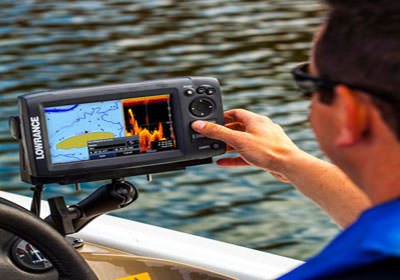
- The number of rays is one of the important, but at the same time controversial parameters, about which many fishermen have differing opinions. The number of beams affects the coverage area of the scanned area. Some people think that 1-2 rays are enough, while others believe that their number should be 4-5. For fishing from a boat, one beam, of course, will be too small for a good overview. With an increase in the number of rays of the device, not only the clarity of the resulting image increases, but also the price, so you need to focus on your own budget. When using a boat, a locator with a number of beams from 2 to 4 will be sufficient. There is no point in purchasing devices with 6 or more beams, since their price is much higher and they are mostly used for fishing on an industrial scale.
- The model and its price are also significant parameters, but they depend directly on the amount of money that the fisherman is willing to spend on purchasing a locator, fishing conditions, necessary characteristics and other details.
Effective use of the device
Most often, the device is installed on a boat, but it is possible to operate the device when the user is on the shore. In all cases, the echo sounder must be adjusted depending on the fishing conditions. It is useful when fishing with a donk, but is also suitable for cases when the fish cannot be detected.
From the boat
When attached to the bottom, the transducer is placed on the floor of the vessel, making sure that there is no layer of air. If the boat speed is high, the device is installed at the rear.
From the shore
Most often, an echo sounder is mounted on a boat, but it can also be used on the shore. The device is placed in the water, thrown nearby, and then the signal is received on a smartphone.
When choosing a device in a store, you must immediately inform that it is required for fishing from the shore, then the required model will be provided.
Features of operation in winter
When starting winter fishing, the fisherman must take into account the following features of using an echo sounder during this period:
- It is necessary to protect the device and battery from cold. Without a protective casing, it can be operated at temperatures down to -10°C, and to work in cold weather you will need to cover it with insulation or make a polystyrene box.
- There are 2 methods of using an echo sounder in winter: the sensor is lowered into a hole or frozen into ice. But both options can create difficulties when trying to change the fishing location.
- Using the automatic fish recognition mode in winter is ineffective.
- It is impossible to determine the bottom topography, since the device stands in one place, and this does not allow exploring a large surface.
In winter, the battery drains faster, so it's worth taking a spare with you. Small lakes can be explored with a single-beam device, but for greater depths a four-beam echo sounder will be required.
Read: Choosing an echo sounder for winter fishing
Safety precautions when working with an echo sounder
Fish finders operate to industry standards, but performance is affected by how well the installation is done.
The screen and cables of the device are located at a distance of 1 m from any other equipment that is capable of emitting radio waves. The distance from the radar installed on the vessel to the echo sounder must be at least 2 m. The power cables of all installations are laid at a distance from each other.
The fish finder works without problems if the factory cable is used. When installing equipment, it is forbidden to remove connectors, and you cannot cut the cable coming from the emitter. When using the device, you must comply with the general safety requirements that apply to devices.
